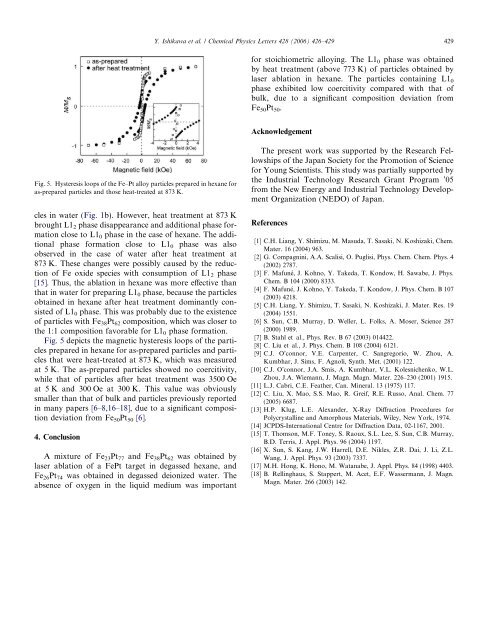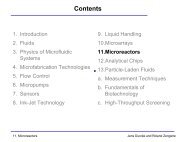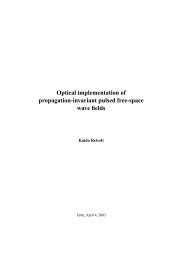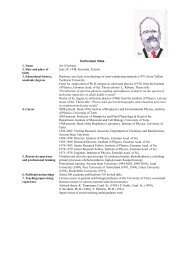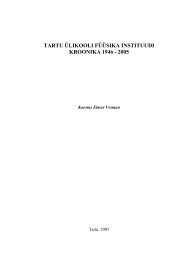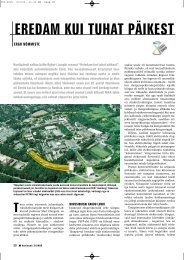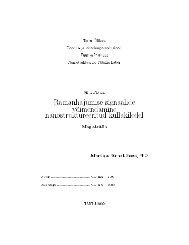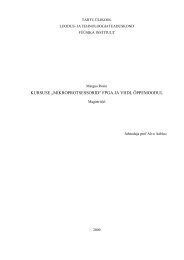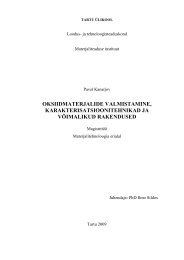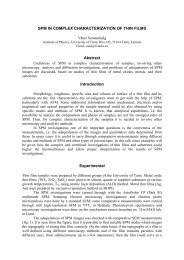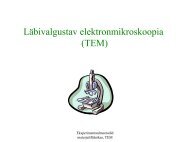Preparation of Fe-Pt alloy particles by pulsed las...
Preparation of Fe-Pt alloy particles by pulsed las...
Preparation of Fe-Pt alloy particles by pulsed las...
You also want an ePaper? Increase the reach of your titles
YUMPU automatically turns print PDFs into web optimized ePapers that Google loves.
Y. Ishikawa et al. / Chemical Physics Letters 428 (2006) 426–429 429<br />
for stoichiometric <strong>alloy</strong>ing. The L1 0 phase was obtained<br />
<strong>by</strong> heat treatment (above 773 K) <strong>of</strong> <strong>particles</strong> obtained <strong>by</strong><br />
<strong>las</strong>er ablation in hexane. The <strong>particles</strong> containing L1 0<br />
phase exhibited low coercitivity compared with that <strong>of</strong><br />
bulk, due to a significant composition deviation from<br />
<strong>Fe</strong> 50 <strong>Pt</strong> 50 .<br />
Acknowledgement<br />
Fig. 5. Hysteresis loops <strong>of</strong> the <strong>Fe</strong>–<strong>Pt</strong> <strong>alloy</strong> <strong>particles</strong> prepared in hexane for<br />
as-prepared <strong>particles</strong> and those heat-treated at 873 K.<br />
cles in water (Fig. 1b). However, heat treatment at 873 K<br />
brought L1 2 phase disappearance and additional phase formation<br />
close to L1 0 phase in the case <strong>of</strong> hexane. The additional<br />
phase formation close to L1 0 phase was also<br />
observed in the case <strong>of</strong> water after heat treatment at<br />
873 K. These changes were possibly caused <strong>by</strong> the reduction<br />
<strong>of</strong> <strong>Fe</strong> oxide species with consumption <strong>of</strong> L1 2 phase<br />
[15]. Thus, the ablation in hexane was more effective than<br />
that in water for preparing L1 0 phase, because the <strong>particles</strong><br />
obtained in hexane after heat treatment dominantly consisted<br />
<strong>of</strong> L1 0 phase. This was probably due to the existence<br />
<strong>of</strong> <strong>particles</strong> with <strong>Fe</strong> 38 <strong>Pt</strong> 62 composition, which was closer to<br />
the 1:1 composition favorable for L1 0 phase formation.<br />
Fig. 5 depicts the magnetic hysteresis loops <strong>of</strong> the <strong>particles</strong><br />
prepared in hexane for as-prepared <strong>particles</strong> and <strong>particles</strong><br />
that were heat-treated at 873 K, which was measured<br />
at 5 K. The as-prepared <strong>particles</strong> showed no coercitivity,<br />
while that <strong>of</strong> <strong>particles</strong> after heat treatment was 3500 Oe<br />
at 5 K and 300 Oe at 300 K. This value was obviously<br />
smaller than that <strong>of</strong> bulk and <strong>particles</strong> previously reported<br />
in many papers [6–8,16–18], due to a significant composition<br />
deviation from <strong>Fe</strong> 50 <strong>Pt</strong> 50 [6].<br />
4. Conclusion<br />
A mixture <strong>of</strong> <strong>Fe</strong> 23 <strong>Pt</strong> 77 and <strong>Fe</strong> 38 <strong>Pt</strong> 62 was obtained <strong>by</strong><br />
<strong>las</strong>er ablation <strong>of</strong> a <strong>Fe</strong><strong>Pt</strong> target in degassed hexane, and<br />
<strong>Fe</strong> 26 <strong>Pt</strong> 74 was obtained in degassed deionized water. The<br />
absence <strong>of</strong> oxygen in the liquid medium was important<br />
The present work was supported <strong>by</strong> the Research <strong>Fe</strong>llowships<br />
<strong>of</strong> the Japan Society for the Promotion <strong>of</strong> Science<br />
for Young Scientists. This study was partially supported <strong>by</strong><br />
the Industrial Technology Research Grant Program ’05<br />
from the New Energy and Industrial Technology Development<br />
Organization (NEDO) <strong>of</strong> Japan.<br />
References<br />
[1] C.H. Liang, Y. Shimizu, M. Masuda, T. Sasaki, N. Koshizaki, Chem.<br />
Mater. 16 (2004) 963.<br />
[2] G. Compagnini, A.A. Scalisi, O. Puglisi, Phys. Chem. Chem. Phys. 4<br />
(2002) 2787.<br />
[3] F. Mafuné, J. Kohno, Y. Takeda, T. Kondow, H. Sawabe, J. Phys.<br />
Chem. B 104 (2000) 8333.<br />
[4] F. Mafuné, J. Kohno, Y. Takeda, T. Kondow, J. Phys. Chem. B 107<br />
(2003) 4218.<br />
[5] C.H. Liang, Y. Shimizu, T. Sasaki, N. Koshizaki, J. Mater. Res. 19<br />
(2004) 1551.<br />
[6] S. Sun, C.B. Murray, D. Weller, L. Folks, A. Moser, Science 287<br />
(2000) 1989.<br />
[7] B. Stahl et al., Phys. Rev. B 67 (2003) 014422.<br />
[8] C. Liu et al., J. Phys. Chem. B 108 (2004) 6121.<br />
[9] C.J. O’connor, V.E. Carpenter, C. Sangregorio, W. Zhou, A.<br />
Kumbhar, J. Sims, F. Agnoli, Synth. Met. (2001) 122.<br />
[10] C.J. O’connor, J.A. Smis, A. Kumbhar, V.L. Kolesnichenko, W.L.<br />
Zhou, J.A. Wiemann, J. Magn. Magn. Mater. 226–230 (2001) 1915.<br />
[11] L.J. Cabri, C.E. <strong>Fe</strong>ather, Can. Mineral. 13 (1975) 117.<br />
[12] C. Liu, X. Mao, S.S. Mao, R. Greif, R.E. Russo, Anal. Chem. 77<br />
(2005) 6687.<br />
[13] H.P. Klug, L.E. Alexander, X-Ray Diffraction Procedures for<br />
Polycrystalline and Amorphous Materials, Wiley, New York, 1974.<br />
[14] JCPDS-International Centre for Diffraction Data, 02-1167, 2001.<br />
[15] T. Thomson, M.F. Toney, S. Raoux, S.L. Lee, S. Sun, C.B. Murray,<br />
B.D. Terris, J. Appl. Phys. 96 (2004) 1197.<br />
[16] X. Sun, S. Kang, J.W. Harrell, D.E. Nikles, Z.R. Dai, J. Li, Z.L.<br />
Wang, J. Appl. Phys. 93 (2003) 7337.<br />
[17] M.H. Hong, K. Hono, M. Watanabe, J. Appl. Phys. 84 (1998) 4403.<br />
[18] B. Rellinghaus, S. Stappert, M. Acet, E.F. Wassermann, J. Magn.<br />
Magn. Mater. 266 (2003) 142.


